News and Site Updates Archive 2010/07/15
Roses are red, Violets are blue, I'm schizophrenic, And so am I.
— Graffiti in New York
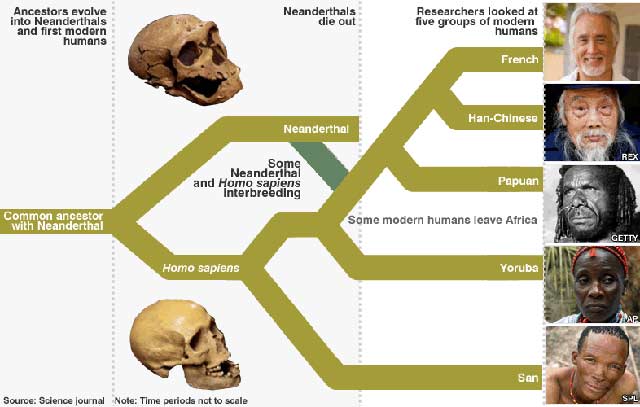
Neanderthal Family Tree
 Recent research has done much to debunk the 19th Century view of Neanderthals as brutish and dumb — even if that image lives on in popular
culture. The ancestors of Neanderthals lived some 400,000 years ago. They mainly evolved north of the Mediterranean while modern humans mainly evolved south of the Mediterranean. Somewhere
along the way modern humans encountered a population of Neanderthals and interbred with them. Researchers have suggested that modern human males could have drawn into their fold some Neanderthal females,
who subsequently bore them children. That they could interbreed shows that they weren't really a separate species. Mainly, 70+ amino acid changes distinguish modern humans from
Neanderthals. Modern humans from Europe and Asia are closer to Neanderthals genetically than are those from
sub-Saharan Africa. Using the Neanderthal genome for comparison, researchers identified the genes that occur frequently in modern humans, suggesting that these genes are the result of selection
pressure. Genes that affect metabolism, cognition and skeletal development show signs of positive selection in modern humans as do genes that when mutated are implicated in Down syndrome, autism and
schizophrenia. A gene in modern humans that makes some people dislike a bitter chemical called phenylthiocarbamide, or PTC (found in Brussels sprouts, broccoli and cabbage),
was found in
Neanderthals. Recent research has done much to debunk the 19th Century view of Neanderthals as brutish and dumb — even if that image lives on in popular
culture. The ancestors of Neanderthals lived some 400,000 years ago. They mainly evolved north of the Mediterranean while modern humans mainly evolved south of the Mediterranean. Somewhere
along the way modern humans encountered a population of Neanderthals and interbred with them. Researchers have suggested that modern human males could have drawn into their fold some Neanderthal females,
who subsequently bore them children. That they could interbreed shows that they weren't really a separate species. Mainly, 70+ amino acid changes distinguish modern humans from
Neanderthals. Modern humans from Europe and Asia are closer to Neanderthals genetically than are those from
sub-Saharan Africa. Using the Neanderthal genome for comparison, researchers identified the genes that occur frequently in modern humans, suggesting that these genes are the result of selection
pressure. Genes that affect metabolism, cognition and skeletal development show signs of positive selection in modern humans as do genes that when mutated are implicated in Down syndrome, autism and
schizophrenia. A gene in modern humans that makes some people dislike a bitter chemical called phenylthiocarbamide, or PTC (found in Brussels sprouts, broccoli and cabbage),
was found in
Neanderthals.
 In the last 2 years, at least 10 US law schools have
deliberately changed their grading systems to make them more lenient, including New York University,
Georgetown, Golden Gate University, Tulane and Loyola. Some inflate grades retroactively. Law schools seem to view higher grades as one way to rescue their students from the tough economic
climate — and perhaps more to the point, to protect their own reputations and rankings. Once able to practically guarantee gainful employment to thousands of students every year, the schools are now
fielding complaints from more and more unemployed graduates, frequently drowning in student debt. Duke and the University of Texas at Austin offer stipends for students to take unpaid public interest
internships. Southern Methodist University’s Dedman School of Law pays profit-making law firms to hire its students. Harvard, Stanford, Yale and the University of California, Berkeley use a modified
pass/fail system, making it harder for employers to distinguish the wheat from the chaff, which means more students can get a shot at a competitive interview. "If somebody’s paying $150,000 for a law
school degree, you don’t want to call that student a loser at the end," says Stuart Rojstaczer, a former geophysics professor at Duke who now studies grade inflation. "So you artificially call every
student a success." In the last 2 years, at least 10 US law schools have
deliberately changed their grading systems to make them more lenient, including New York University,
Georgetown, Golden Gate University, Tulane and Loyola. Some inflate grades retroactively. Law schools seem to view higher grades as one way to rescue their students from the tough economic
climate — and perhaps more to the point, to protect their own reputations and rankings. Once able to practically guarantee gainful employment to thousands of students every year, the schools are now
fielding complaints from more and more unemployed graduates, frequently drowning in student debt. Duke and the University of Texas at Austin offer stipends for students to take unpaid public interest
internships. Southern Methodist University’s Dedman School of Law pays profit-making law firms to hire its students. Harvard, Stanford, Yale and the University of California, Berkeley use a modified
pass/fail system, making it harder for employers to distinguish the wheat from the chaff, which means more students can get a shot at a competitive interview. "If somebody’s paying $150,000 for a law
school degree, you don’t want to call that student a loser at the end," says Stuart Rojstaczer, a former geophysics professor at Duke who now studies grade inflation. "So you artificially call every
student a success."
 Doctors, psychologists and other professionals monitoring the CIA’s use of
waterboarding, sleep deprivation and other "enhanced" interrogation techniques gathered and collected data on the impact on the detainees in order to refine those techniques and ensure that they stayed within
the limits established by the Bush Administration’s lawyers. But, by doing so, medical professionals turned the detainees into
research subjects, according to a report by Physicians for Human Rights (PHR). The data collected from the interrogations allowed the CIA to judge emotional and physical impacts of the
techniques, helping them to calibrate the level of pain experienced by detainees during interrogation, ostensibly to keep it from crossing the legal threshold of what it claimed constituted
torture. That meant that medical professionals crossed the line from treating the detainees as patients to treating them as research subjects. It appears the CIA used health-care professionals to
collect data for two purposes: to try to hone torture techniques, and to create a "good faith" defence against criminal charges (following the advice of the Justice Department). The established practice
of medical experimentation and data collection during torture sessions means that a substantial pool of information about these sessions exists, as do eye-witnesses – the collaborating health-care
professionals. To the extent it figures in the pending legal cases of persons subject to these procedures, this information must be disclosed for court use. But it also constitutes an invaluable
source of data about the entire programme, which must be carefully preserved. Doctors, psychologists and other professionals monitoring the CIA’s use of
waterboarding, sleep deprivation and other "enhanced" interrogation techniques gathered and collected data on the impact on the detainees in order to refine those techniques and ensure that they stayed within
the limits established by the Bush Administration’s lawyers. But, by doing so, medical professionals turned the detainees into
research subjects, according to a report by Physicians for Human Rights (PHR). The data collected from the interrogations allowed the CIA to judge emotional and physical impacts of the
techniques, helping them to calibrate the level of pain experienced by detainees during interrogation, ostensibly to keep it from crossing the legal threshold of what it claimed constituted
torture. That meant that medical professionals crossed the line from treating the detainees as patients to treating them as research subjects. It appears the CIA used health-care professionals to
collect data for two purposes: to try to hone torture techniques, and to create a "good faith" defence against criminal charges (following the advice of the Justice Department). The established practice
of medical experimentation and data collection during torture sessions means that a substantial pool of information about these sessions exists, as do eye-witnesses – the collaborating health-care
professionals. To the extent it figures in the pending legal cases of persons subject to these procedures, this information must be disclosed for court use. But it also constitutes an invaluable
source of data about the entire programme, which must be carefully preserved.
  The views that potential tourists aren't meant to see: The views that potential tourists aren't meant to see:
Statue of Liberty, from Caven Point, Jersey City, New Jersey, 1967
Stonehenge: Assuming planning permission
is granted, construction work is expected to take place in 2011,
with new visitor facilities scheduled to open in 2012 in time for the London Olympics.

On the other hand, this is my new favourite photo of the Statue of Liberty.
As of mid-2009, the crown of the statue reopened for tourists for the first time
after the terrorist attacks in 2001.
The base, pedestal and outdoor observation deck were reopened in 2004, but the crown remained off-limits.
The National Park Service kept it closed because the narrow, double-helix staircases couldn't be safely evacuated in emergencies and didn’t comply with fire and building codes.
Tourists often suffered heat exhaustion, shortness of breath, panic attacks, claustrophobia and fear of heights.
Click on the photo above for a medium version or click here once for a rather large version.
 So what brought down the Air France plane in the
Atlantic? There was a thunderstorm in the area at the time. But why would experienced pilots fly into a storm? Several other flights that night took the same route as Flight 447, but the
pilots made detours of up to 90 miles to avoid the storm system, which towered to an altitude of 50,000 feet. The investigating team believes that a smaller storm in front of the larger weather front
confused the flight's radar system, so the crew didn't see the thunderstorm coming. At 2:10am it appears the plane entered the rapidly developing system its radar detected too late. The pilot would
have slowed down the engines — standard for flying through such conditions. But a little more than 4 minutes later, after suffering 24 critical faults, everyone on board was dead. The autopilot
switched itself off; the pilot had to take manual control. The systems controlling air speed and altitude failed. In the cockpit, instrument display screens would have gone blank and flight-control
computers would have died one by one, removing the most critical safety features in the cockpit, which would've filled with a multitude of audio and visual alarms while the pilots desperately fought a losing
battle to control an aircraft buffeted by the gigantic thunderstorm. The plane began a swift descent — it appears the 3 pitot tubes (speed sensors) failed simultaneously. Super-cooled water in the
clouds — well below freezing, but too pure to turn into ice — could have been the cause. Indeed, in 2007, Airbus had recommended a refit of all A330s with upgraded pitots but Flight 447 hadn't yet done
this. With no airspeed data, the automatic systems collapsed one by one. Accustomed to flying with high levels of automation, it seems pilots lacked skills to recover. Tragically, from the way the
plane hit the water — nose up, wings level — it appears the crew may have come very close to saving the passengers' lives — it's likely they just ran out of time. More than this may never be
known. So what brought down the Air France plane in the
Atlantic? There was a thunderstorm in the area at the time. But why would experienced pilots fly into a storm? Several other flights that night took the same route as Flight 447, but the
pilots made detours of up to 90 miles to avoid the storm system, which towered to an altitude of 50,000 feet. The investigating team believes that a smaller storm in front of the larger weather front
confused the flight's radar system, so the crew didn't see the thunderstorm coming. At 2:10am it appears the plane entered the rapidly developing system its radar detected too late. The pilot would
have slowed down the engines — standard for flying through such conditions. But a little more than 4 minutes later, after suffering 24 critical faults, everyone on board was dead. The autopilot
switched itself off; the pilot had to take manual control. The systems controlling air speed and altitude failed. In the cockpit, instrument display screens would have gone blank and flight-control
computers would have died one by one, removing the most critical safety features in the cockpit, which would've filled with a multitude of audio and visual alarms while the pilots desperately fought a losing
battle to control an aircraft buffeted by the gigantic thunderstorm. The plane began a swift descent — it appears the 3 pitot tubes (speed sensors) failed simultaneously. Super-cooled water in the
clouds — well below freezing, but too pure to turn into ice — could have been the cause. Indeed, in 2007, Airbus had recommended a refit of all A330s with upgraded pitots but Flight 447 hadn't yet done
this. With no airspeed data, the automatic systems collapsed one by one. Accustomed to flying with high levels of automation, it seems pilots lacked skills to recover. Tragically, from the way the
plane hit the water — nose up, wings level — it appears the crew may have come very close to saving the passengers' lives — it's likely they just ran out of time. More than this may never be
known.
 Frequent flyer tickets are never quite free. They have become fraught in recent years with added fees and
restrictions, like the $50 to $100 charge most airlines tack on for reservations made less than 3 weeks in advance. (Just what extra cost does the airline incur for booking a frequent flyer ticket 20
days in advance versus 21 days?) Other perks of frequent flyer travel — such as the ability to make a stop on one leg of a round trip (once allowed by American, but no more) and the ability to change
flight times without a fee — have steadily been taken away by most airlines. But the biggest problem for frequent flyers is simply being able to use those reward miles. Unless you book months, or
even a year, in advance, seats on the most travelled routes and times are almost never available. The airlines typically set aside a few frequent flyer seats on each flight (it varies according to
capacity); once they're gone, you're out of luck. Airlines have cut back flight numbers in response to the recession while traffic ratchets up, leaving frequent flyers out in the cold. Some compare
the situation to an inflationary monetary system: with the profusion of frequent flyer deals (consumers earn mileage by signing up for credit cards, refinancing their homes, joining Netflix and much more),
more miles are "printed" so each mile has less value. Airlines have cut capacity while handing out frequent flyer miles like hotcakes — anyone can get a free ticket, making it harder for everyone to do
so. Members of airline loyalty programmes worldwide are sitting on a monster-size cache of at least 9 trillion
frequent-flier miles. Frequent flyer tickets are never quite free. They have become fraught in recent years with added fees and
restrictions, like the $50 to $100 charge most airlines tack on for reservations made less than 3 weeks in advance. (Just what extra cost does the airline incur for booking a frequent flyer ticket 20
days in advance versus 21 days?) Other perks of frequent flyer travel — such as the ability to make a stop on one leg of a round trip (once allowed by American, but no more) and the ability to change
flight times without a fee — have steadily been taken away by most airlines. But the biggest problem for frequent flyers is simply being able to use those reward miles. Unless you book months, or
even a year, in advance, seats on the most travelled routes and times are almost never available. The airlines typically set aside a few frequent flyer seats on each flight (it varies according to
capacity); once they're gone, you're out of luck. Airlines have cut back flight numbers in response to the recession while traffic ratchets up, leaving frequent flyers out in the cold. Some compare
the situation to an inflationary monetary system: with the profusion of frequent flyer deals (consumers earn mileage by signing up for credit cards, refinancing their homes, joining Netflix and much more),
more miles are "printed" so each mile has less value. Airlines have cut capacity while handing out frequent flyer miles like hotcakes — anyone can get a free ticket, making it harder for everyone to do
so. Members of airline loyalty programmes worldwide are sitting on a monster-size cache of at least 9 trillion
frequent-flier miles.
 Conjoined twins of the type craniopagus are joined at the crowns of the heads. The
junction may be more or less extensive: in partial craniopagi, the crania are intact or simply fused, while in total craniopagi, the two brains are encased in a common cranium. In the former subgroup,
the brains are often quite intact, but those of the latter subgroup are sometimes malformed. Craniopagi was described several times in old annals of teratology. The famous twins of Worms, born in
1495 and depicted in several crude woodcuts of the time, were frontal craniopagi and lived for 10 years. During the 18th century, several well-attested cases were reported. Today, at least 80 bona
fide cases of craniopagus conjoined twins have been described; this type represents 6% of all double conjoins, making the incidence 0.6 per million births. The surgical techniques for separating
craniopagus twins have greatly improved during the last decades, but the operation is still a most uncertain and difficult venture, especially in cases with total conjunction and malformations of the brains
and their vascular supply. Conjoined twins Abby and Brittany Hensel are examples of the exact opposite — their heads are their only completely separate parts. Conjoined twins of the type craniopagus are joined at the crowns of the heads. The
junction may be more or less extensive: in partial craniopagi, the crania are intact or simply fused, while in total craniopagi, the two brains are encased in a common cranium. In the former subgroup,
the brains are often quite intact, but those of the latter subgroup are sometimes malformed. Craniopagi was described several times in old annals of teratology. The famous twins of Worms, born in
1495 and depicted in several crude woodcuts of the time, were frontal craniopagi and lived for 10 years. During the 18th century, several well-attested cases were reported. Today, at least 80 bona
fide cases of craniopagus conjoined twins have been described; this type represents 6% of all double conjoins, making the incidence 0.6 per million births. The surgical techniques for separating
craniopagus twins have greatly improved during the last decades, but the operation is still a most uncertain and difficult venture, especially in cases with total conjunction and malformations of the brains
and their vascular supply. Conjoined twins Abby and Brittany Hensel are examples of the exact opposite — their heads are their only completely separate parts.
 Tatiana
and Krista Hogan are craniopagus conjoined twins, joined at the top, backs, and sides of their heads. Their nervous systems are highly interconnected; when one of the girls is tickled, the other
jumps; putting a pacifier in the mouth of one causes the other to stop crying. There is suspicion that they see through each other's eyes due to the fact that their thalamuses are
joined. The thalamus controls every sensory system (with the exception of the olfactory) via a thalamic nucleus that receives sensory
signals and sends them to associated cortical areas. For the visual system, inputs from the retina are sent to the thalamus, which in turn projects to the primary visual cortex. The thalamus both
processes sensory information and relays it. It also plays an important role in regulating states of sleep and wakefulness and is believed to be involved with consciousness. It plays a major role
in regulating arousal, level of awareness, and activity. In 1996, a boy was born in China
with total craniopagi, two brains encased in a common cranium (the brains slept at different times allowing him to be constantly awake). He was (is? I could find no current news) two people sharing
one body. Tatiana and Krista may be more like one person with two bodies. In Britain, a boy was born
who, genetically, was two people, formed when two eggs, fertilised by two different sperm, fused into one embryo inside the mother's womb. Investigation revealed that some parts of his body were
genetically female but the rest, containing a different combination of his parents' genes, were male. Clearly the definition of "person" or "individual" doesn't apply in many
cases. Tatiana
and Krista Hogan are craniopagus conjoined twins, joined at the top, backs, and sides of their heads. Their nervous systems are highly interconnected; when one of the girls is tickled, the other
jumps; putting a pacifier in the mouth of one causes the other to stop crying. There is suspicion that they see through each other's eyes due to the fact that their thalamuses are
joined. The thalamus controls every sensory system (with the exception of the olfactory) via a thalamic nucleus that receives sensory
signals and sends them to associated cortical areas. For the visual system, inputs from the retina are sent to the thalamus, which in turn projects to the primary visual cortex. The thalamus both
processes sensory information and relays it. It also plays an important role in regulating states of sleep and wakefulness and is believed to be involved with consciousness. It plays a major role
in regulating arousal, level of awareness, and activity. In 1996, a boy was born in China
with total craniopagi, two brains encased in a common cranium (the brains slept at different times allowing him to be constantly awake). He was (is? I could find no current news) two people sharing
one body. Tatiana and Krista may be more like one person with two bodies. In Britain, a boy was born
who, genetically, was two people, formed when two eggs, fertilised by two different sperm, fused into one embryo inside the mother's womb. Investigation revealed that some parts of his body were
genetically female but the rest, containing a different combination of his parents' genes, were male. Clearly the definition of "person" or "individual" doesn't apply in many
cases.


Mike Hollingshead follows about 40 storms a year, clocking up
about 20,000 miles (32,000 kilometres) across the US annually.
He races after storm warnings in the hope of capturing tornadoes on film. "The only way to witness these crazy formations is to go and chase them," the photographer said.
Before finally catching up with this storm in Nebraska, he saw 3 tornadoes created by
it. Slideshow.
 Walking Tornado, Jarrell, Texas, 27 May
1997. From the weather station's .pdf file: "Initially, the tornado was quite weak and small,
probably being no more than F0 or F1. It moved slowly south-southwest, crossing into Williamson County at approximately 3:25pm. Shortly thereafter, the tornado explosively strengthened, becoming a
multi-vortex F5 tornado before moving into the Double Creek Estates subdivision on the west side of Jarrell at 3:40pm. Walking Tornado, Jarrell, Texas, 27 May
1997. From the weather station's .pdf file: "Initially, the tornado was quite weak and small,
probably being no more than F0 or F1. It moved slowly south-southwest, crossing into Williamson County at approximately 3:25pm. Shortly thereafter, the tornado explosively strengthened, becoming a
multi-vortex F5 tornado before moving into the Double Creek Estates subdivision on the west side of Jarrell at 3:40pm.
Here, devastation was complete."
 There are a fair number of RSA Animate videos on YouTube but, though the technique used is
truly impressive, the actual message of all the ones I saw leaves me unimpressed. This one is adapted from Dan Pink's talk
illustrating the hidden truths behind what really motivates us — one of the least offensive ones. The figures are brilliant and free-handed with (apparently) never a mistake. There are a fair number of RSA Animate videos on YouTube but, though the technique used is
truly impressive, the actual message of all the ones I saw leaves me unimpressed. This one is adapted from Dan Pink's talk
illustrating the hidden truths behind what really motivates us — one of the least offensive ones. The figures are brilliant and free-handed with (apparently) never a mistake.
According to their website, for over 250 years the Royal Society for the encouragement of Arts, Manufactures and Commerce (RSA) has been a cradle of
enlightenment thinking and a force for social progress. More (if you're interested).
 The Inner Life of the
Cell is a short 3D computer graphics animation demonstrating various biological mechanisms that occur within a human's white blood cell. When teaching biology, professors often generate
3D animations to demonstrate certain concepts to their students in a more visual way than would otherwise be possible. In this case, creators aimed for a more cinematic, as opposed to academic,
feel — and in my opinion achieved it admirably. The animation was created for Harvard's Department of Molecular and Cellular Biology. The movie, 8½ minutes of animation, took 14 months to
complete. Narrated, 8½ minute version here. Larger version of the 3½ minute animation with music rather than
narration here. The incredible complexity of a single cell is rather
overwhelming. And we have something like 75 trillion cells. The Inner Life of the
Cell is a short 3D computer graphics animation demonstrating various biological mechanisms that occur within a human's white blood cell. When teaching biology, professors often generate
3D animations to demonstrate certain concepts to their students in a more visual way than would otherwise be possible. In this case, creators aimed for a more cinematic, as opposed to academic,
feel — and in my opinion achieved it admirably. The animation was created for Harvard's Department of Molecular and Cellular Biology. The movie, 8½ minutes of animation, took 14 months to
complete. Narrated, 8½ minute version here. Larger version of the 3½ minute animation with music rather than
narration here. The incredible complexity of a single cell is rather
overwhelming. And we have something like 75 trillion cells.
 Père Lachaise Cemetery is the largest cemetery in the city of Paris. Located in the 20th arrondissement, it is
reputed to be the world's most-visited cemetery, attracting hundreds of thousands of visitors annually to graves of those who enhanced French life over the past 200 years. The cemetery was established by
Napoléon I in 1804. Cemeteries were banned inside Paris in 1786 on the grounds that they presented a health hazard. At the time of its opening, this cemetery was far from the city — and thus
attracted few funerals. Consequently, administrators devised a marketing strategy: with great fanfare, they organised the transfer of the remains of La Fontaine and Molière in 1804. Then, in
another great spectacle in 1817, the purported remains of Pierre Abélard and Héloïse were also transferred in. Today there are over 300,000 bodies buried and many more in the columbarium, which holds the
remains of the cremated. In division 92, 19th-century journalist Victor Noir — shot at age 22 for daring to criticise a relative of
Napoléon III — lies flat on his back, fully clothed, his top hat fallen by his feet. The sculpture has a very noticeable protuberance in Noir's trousers. This has made it one of the most popular
memorials for women to visit. Myth says that placing a flower in the upturned top hat after kissing Noir on the lips and rubbing his genital area will enhance fertility, bring a blissful sex life, or, in
some versions, a husband within the year. As a result of the legend, those particular components of the oxidised bronze statue are now rather well-worn and the grave has subsequently been fenced
off. In division 71, two men lie together hand in hand — not a gay couple (as far as anyone knows); but a pair of
balloonists who went so high they died from lack of oxygen. Père Lachaise Cemetery is the largest cemetery in the city of Paris. Located in the 20th arrondissement, it is
reputed to be the world's most-visited cemetery, attracting hundreds of thousands of visitors annually to graves of those who enhanced French life over the past 200 years. The cemetery was established by
Napoléon I in 1804. Cemeteries were banned inside Paris in 1786 on the grounds that they presented a health hazard. At the time of its opening, this cemetery was far from the city — and thus
attracted few funerals. Consequently, administrators devised a marketing strategy: with great fanfare, they organised the transfer of the remains of La Fontaine and Molière in 1804. Then, in
another great spectacle in 1817, the purported remains of Pierre Abélard and Héloïse were also transferred in. Today there are over 300,000 bodies buried and many more in the columbarium, which holds the
remains of the cremated. In division 92, 19th-century journalist Victor Noir — shot at age 22 for daring to criticise a relative of
Napoléon III — lies flat on his back, fully clothed, his top hat fallen by his feet. The sculpture has a very noticeable protuberance in Noir's trousers. This has made it one of the most popular
memorials for women to visit. Myth says that placing a flower in the upturned top hat after kissing Noir on the lips and rubbing his genital area will enhance fertility, bring a blissful sex life, or, in
some versions, a husband within the year. As a result of the legend, those particular components of the oxidised bronze statue are now rather well-worn and the grave has subsequently been fenced
off. In division 71, two men lie together hand in hand — not a gay couple (as far as anyone knows); but a pair of
balloonists who went so high they died from lack of oxygen.



Brody Jewish Cemetery: From the entire pre-war Jewish
population of 9,000 in Brody,
only 88 people lived to see the subsequent liberation.
So many are buried in the Prague Jewish Cemetery that they're up to 12 bodies deep, resulting in a graveyard crammed
with headstones only a few inches apart.
Path through the Krakow Jewish Cemetery in Poland.
 If you use standard tap water in your windshield washer fluid reservoir instead
of a cleaner, you may have effectively turned your vehicle into a biological weapon. Sure, that sounds cool and all, but the only person you're going to be hurting is yourself. As it turns out,
using plain water can cause the washer fluid system to become a breeding ground for
Legionella bacterium – the same nastiness that causes legionaires' disease (often fatal, characterised by high fever, gastrointestinal pain, headache, and pneumonia). Spray your windshield and the
bacteria becomes airborne, allowing it to easily enter your lungs and wreak havoc with your immune system. This is why professional drivers are 5 times more likely to become ill than their amateur
counterparts. Purpose-built cleaner will kill infection-causing bacteria and additionally keep the fluid from freezing in the winter. If you use standard tap water in your windshield washer fluid reservoir instead
of a cleaner, you may have effectively turned your vehicle into a biological weapon. Sure, that sounds cool and all, but the only person you're going to be hurting is yourself. As it turns out,
using plain water can cause the washer fluid system to become a breeding ground for
Legionella bacterium – the same nastiness that causes legionaires' disease (often fatal, characterised by high fever, gastrointestinal pain, headache, and pneumonia). Spray your windshield and the
bacteria becomes airborne, allowing it to easily enter your lungs and wreak havoc with your immune system. This is why professional drivers are 5 times more likely to become ill than their amateur
counterparts. Purpose-built cleaner will kill infection-causing bacteria and additionally keep the fluid from freezing in the winter.
 Oxytocin produces trust; acts as social lubricant; increases generosity; allays
fears; reduces stress. Unfortunately, no oxytocin pill works because to cross the blood-brain barrier, it must be inhaled through a nasal
spray. The best way to access oxytocin is to promote your own
endogenous secretion. Love relationships often begin with the intoxicating double whammy of lust and romance; the dizzy spin of dopamine and norepinephrine makes it difficult to come down to
earth. But to move to the more stable next level needs hand-holding, touching, hugging, cuddling — skin-to-skin contact (gloved touches don't work). All promote oxytocin secretion in the
hypothalamus creating mutual trust, understanding, lasting warmth, affection, the illusion of security, profound wellbeing. If distance separates you from loved ones, even a phone conversation can
elevate levels. Between relationships? Keep a pet, especially one to hold and cuddle as this enhances oxytocin levels. Besides stroking, it's important to keep eye contact. Cognitive
and emotional empathy are produced by eye contact. (Oxytocin and dopamine are humbly prescribed as names for your next dogs or cats.) Contact with skin during a gentle massage enhances levels as do
religious and spiritual activities. Meditating, community activities, support groups, worshipping, and singing together all do the same. (And 2 masseurs are twice as good!) Oxytocin helps
reduce addictions — unsurprising that Alcoholics Anonymous and other de-addiction groups (with the oxytocin they generate) succeed better than individual efforts. Oxytocin produces trust; acts as social lubricant; increases generosity; allays
fears; reduces stress. Unfortunately, no oxytocin pill works because to cross the blood-brain barrier, it must be inhaled through a nasal
spray. The best way to access oxytocin is to promote your own
endogenous secretion. Love relationships often begin with the intoxicating double whammy of lust and romance; the dizzy spin of dopamine and norepinephrine makes it difficult to come down to
earth. But to move to the more stable next level needs hand-holding, touching, hugging, cuddling — skin-to-skin contact (gloved touches don't work). All promote oxytocin secretion in the
hypothalamus creating mutual trust, understanding, lasting warmth, affection, the illusion of security, profound wellbeing. If distance separates you from loved ones, even a phone conversation can
elevate levels. Between relationships? Keep a pet, especially one to hold and cuddle as this enhances oxytocin levels. Besides stroking, it's important to keep eye contact. Cognitive
and emotional empathy are produced by eye contact. (Oxytocin and dopamine are humbly prescribed as names for your next dogs or cats.) Contact with skin during a gentle massage enhances levels as do
religious and spiritual activities. Meditating, community activities, support groups, worshipping, and singing together all do the same. (And 2 masseurs are twice as good!) Oxytocin helps
reduce addictions — unsurprising that Alcoholics Anonymous and other de-addiction groups (with the oxytocin they generate) succeed better than individual efforts.
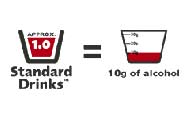 The liver has the job of breaking down alcohol. It has plenty of other things
to do as well, such as producing blood clotting agents and draining almost the entire blood supply from the digestive system to metabolise your food. Once your consumption of alcohol goes above a certain
level, the liver diverts nearly all its resources into dealing with the onslaught. Push it even further and the liver cells themselves start to get damaged, eventually leading to that famous companion of
chronic excess drinking, cirrhosis. A cirrhotic liver is difficult to pump blood through. Pressure in blood vessels within the liver rises, eventually leading to widening of veins inside the
gullet. These œsophageal varices are pretty much as they sound – varicose veins in your œsophagus. When they burst, they bleed. A lot. And by the time varices have developed, the
degree of liver damage established means the blood is not clotting as it should. Bleeding œsophageal varices used to be something seen in middle-aged and older heavy drinkers but not any more. A
unit of alcohol is defined as 10 millilitres of pure alcohol (ethanol) — it is not the same thing as a standard
drink. The size of standard drinks varies significantly from country to country. In Japan, a standard drink is 25
millilitres of alcohol (19.75 grams) while in Austria it is 1/3 of that — 7.62 millilitres (6 grams). In the US it is 17.7 millilitres (14 grams) and in NZ it is 12.7 millilitres (10 grams — conveniently same
as one unit). A unit of alcohol is the same everywhere — in general, it is the amount of alcohol the body can metabolise in 1 hour. The liver has the job of breaking down alcohol. It has plenty of other things
to do as well, such as producing blood clotting agents and draining almost the entire blood supply from the digestive system to metabolise your food. Once your consumption of alcohol goes above a certain
level, the liver diverts nearly all its resources into dealing with the onslaught. Push it even further and the liver cells themselves start to get damaged, eventually leading to that famous companion of
chronic excess drinking, cirrhosis. A cirrhotic liver is difficult to pump blood through. Pressure in blood vessels within the liver rises, eventually leading to widening of veins inside the
gullet. These œsophageal varices are pretty much as they sound – varicose veins in your œsophagus. When they burst, they bleed. A lot. And by the time varices have developed, the
degree of liver damage established means the blood is not clotting as it should. Bleeding œsophageal varices used to be something seen in middle-aged and older heavy drinkers but not any more. A
unit of alcohol is defined as 10 millilitres of pure alcohol (ethanol) — it is not the same thing as a standard
drink. The size of standard drinks varies significantly from country to country. In Japan, a standard drink is 25
millilitres of alcohol (19.75 grams) while in Austria it is 1/3 of that — 7.62 millilitres (6 grams). In the US it is 17.7 millilitres (14 grams) and in NZ it is 12.7 millilitres (10 grams — conveniently same
as one unit). A unit of alcohol is the same everywhere — in general, it is the amount of alcohol the body can metabolise in 1 hour.
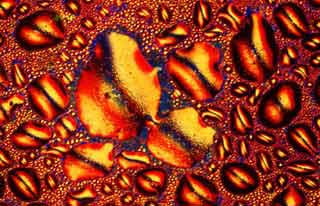

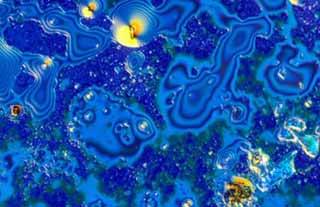
Whiskey
Tequila
Scotch
Pictures of alcoholic drinks under a microscope reveal the molecules that make it up.
Just like images of snowflakes, each drink is different when magnified up to 1,000 times under a laboratory microscope.
The pictures were taken in Florida State University's chemistry department; produced by American firm Bevshots,
they are on offer as art works for buyers who appreciate the hidden beauty of booze.
 Although buildings of all types have become more energy efficient on a
per-square-foot basis for the past 50 years, many buildings constructed over the past decade have bucked the trend and have begun regressing on energy efficiency. This reversal comes despite newfound
interest in "green building" among governments, occupants, and the building owners themselves, and despite the plethora of insulation, window, equipment, and other devices that yield far greater
efficiencies. The proximate cause of the backslide in efficiency is a switch to less expensive aluminium wall
studs in place of wood or block in recent years. Because aluminium is such a good conductor of heat, walls that are otherwise well-insulated – with insulation batts installed between the studs – see
an overall insulating R-value of the wall drop in half, from 11 or more to 5. Thermal images of walls are particularly poignant, showing relatively small amounts of heat escaping from between the studs,
while the studs themselves are lit up like Christmas trees. Via the New Shelton
wet/dry. Although buildings of all types have become more energy efficient on a
per-square-foot basis for the past 50 years, many buildings constructed over the past decade have bucked the trend and have begun regressing on energy efficiency. This reversal comes despite newfound
interest in "green building" among governments, occupants, and the building owners themselves, and despite the plethora of insulation, window, equipment, and other devices that yield far greater
efficiencies. The proximate cause of the backslide in efficiency is a switch to less expensive aluminium wall
studs in place of wood or block in recent years. Because aluminium is such a good conductor of heat, walls that are otherwise well-insulated – with insulation batts installed between the studs – see
an overall insulating R-value of the wall drop in half, from 11 or more to 5. Thermal images of walls are particularly poignant, showing relatively small amounts of heat escaping from between the studs,
while the studs themselves are lit up like Christmas trees. Via the New Shelton
wet/dry.
 Vanilla is a flavouring derived from orchids native to Mexico. Originally cultivated by pre-Columbian Mesoamerican peoples, Spanish
conquistador Hernán Cortés introduced it to Europe in the 1520s. Attempts to cultivate outside Mexico proved futile because of the symbiotic relationship between the vine producing the vanilla orchid and
a local species of bee; in 1837, a Belgian botanist pioneered a method of artificially pollination, but it was financially unworkable. However, in 1841, a 12-year-old French-owned slave in Madagascar
discovered a method of hand pollination that allowed global cultivation. Currently, 3 major areas grow
vanilla:
Vanilla is a flavouring derived from orchids native to Mexico. Originally cultivated by pre-Columbian Mesoamerican peoples, Spanish
conquistador Hernán Cortés introduced it to Europe in the 1520s. Attempts to cultivate outside Mexico proved futile because of the symbiotic relationship between the vine producing the vanilla orchid and
a local species of bee; in 1837, a Belgian botanist pioneered a method of artificially pollination, but it was financially unworkable. However, in 1841, a 12-year-old French-owned slave in Madagascar
discovered a method of hand pollination that allowed global cultivation. Currently, 3 major areas grow
vanilla:  Madagascar, Réunion and other tropical areas along the Indian
Ocean Madagascar, Réunion and other tropical areas along the Indian
Ocean  South Pacific South Pacific  West
Indies / Central and South America. Vanilla is 2nd only to saffron in expense to grow due to the extensive labour required. (95% of so-called vanilla products contain artificial vanillin,
produced from lignin, derived from wood.) The flower lasts a day or less, so growers must inspect plants every day for open flowers, a labour-intensive task. One fertilised flower produces one
fruit — a seed capsule — which ripens on the plant until it opens at the end; as it dries, phenolic compounds crystallise, giving beans a diamond-dusted appearance the French call givre (hoarfrost) and
it releases its distinctive smell. Harvest maturity takes 10 months. To ensure best flavour from every bean, each pod must be hand-picked as it just begins splitting. Vanilla essence comes in 2
forms: real seedpod extract is an extremely complicated mixture of several hundred compounds; synthetic essence is basically vanillin (by-product of the pulp and paper industry) in ethanol. In in-vitro
tests vanilla blocks quorum sensing in bacteria — medically interesting because in many bacteria, quorum sensing controls virulence as microbes only attack when signals indicate that they have the numbers to
resist the host immune system response. West
Indies / Central and South America. Vanilla is 2nd only to saffron in expense to grow due to the extensive labour required. (95% of so-called vanilla products contain artificial vanillin,
produced from lignin, derived from wood.) The flower lasts a day or less, so growers must inspect plants every day for open flowers, a labour-intensive task. One fertilised flower produces one
fruit — a seed capsule — which ripens on the plant until it opens at the end; as it dries, phenolic compounds crystallise, giving beans a diamond-dusted appearance the French call givre (hoarfrost) and
it releases its distinctive smell. Harvest maturity takes 10 months. To ensure best flavour from every bean, each pod must be hand-picked as it just begins splitting. Vanilla essence comes in 2
forms: real seedpod extract is an extremely complicated mixture of several hundred compounds; synthetic essence is basically vanillin (by-product of the pulp and paper industry) in ethanol. In in-vitro
tests vanilla blocks quorum sensing in bacteria — medically interesting because in many bacteria, quorum sensing controls virulence as microbes only attack when signals indicate that they have the numbers to
resist the host immune system response.
 A 13-month-old Ohio boy ingested a "button" battery, a flat silver disc used to power
remote controls, toys, bathroom scales and other home electronics. The battery was surgically removed the next day and he was sent home — but neither the doctors nor his parents realised that the
battery’s current had set off a chemical reaction in his œsophagus, burning through the œsophageal wall and attacking the aorta. Two days after the battery was removed, the boy began coughing blood and
soon died. Such deaths are extremely rare — fewer than 10 documented during the past 6 years — but ingestion of lithium cell batteries (which children may mistake
for candy and elderly adults for medication) is a surprisingly common problem. About 3,500 cases of ingestion are reported annually in the US. But while swallowing batteries has occurred for
years, the development of larger, stronger lithium cell batteries increases risks of severe complications — by 7-fold in recent years. Among serious complications: chemical reactions can damage vocal
cords, leaving children with a lifelong whisper. Damage to the gastrointestinal tract means some children require feeding tubes and multiple surgeries. It’s like drain opener or lye — not something
you want in your child's œsophagus. Batteries numbers with greatest risk begin with a 20 (which stands for 20 millimetres); they are larger and stronger than older models. Batteries numbered 2032,
2025, and 2016 are responsible for more than 90% of serious injuries. In most cases involving children under age 6, the child removes the battery from an electronic device with most parents not even
aware — and the battery begins causing severe damage within just 2 hours. The solution? Secure battery cases in all devices. A 13-month-old Ohio boy ingested a "button" battery, a flat silver disc used to power
remote controls, toys, bathroom scales and other home electronics. The battery was surgically removed the next day and he was sent home — but neither the doctors nor his parents realised that the
battery’s current had set off a chemical reaction in his œsophagus, burning through the œsophageal wall and attacking the aorta. Two days after the battery was removed, the boy began coughing blood and
soon died. Such deaths are extremely rare — fewer than 10 documented during the past 6 years — but ingestion of lithium cell batteries (which children may mistake
for candy and elderly adults for medication) is a surprisingly common problem. About 3,500 cases of ingestion are reported annually in the US. But while swallowing batteries has occurred for
years, the development of larger, stronger lithium cell batteries increases risks of severe complications — by 7-fold in recent years. Among serious complications: chemical reactions can damage vocal
cords, leaving children with a lifelong whisper. Damage to the gastrointestinal tract means some children require feeding tubes and multiple surgeries. It’s like drain opener or lye — not something
you want in your child's œsophagus. Batteries numbers with greatest risk begin with a 20 (which stands for 20 millimetres); they are larger and stronger than older models. Batteries numbered 2032,
2025, and 2016 are responsible for more than 90% of serious injuries. In most cases involving children under age 6, the child removes the battery from an electronic device with most parents not even
aware — and the battery begins causing severe damage within just 2 hours. The solution? Secure battery cases in all devices.
 Sixty-two student participants, half of them female, rated the dominance and/or attractiveness of
the photographed faces of 40 men and 40 women. All models were Caucasian, and all of them were holding a neutral
expression. Men with brown eyes were rated consistently as more dominant than blue-eyed
men. No such effect of eye-colour was found for the photos of women. Eye colour also bore no association to attractiveness ratings. Next, researchers used Photoshop to give the brown-eyed
men blue eyes and the blue-eyed men brown eyes. The photos were then rated by a new batch of participants. The intriguing finding here was that the dominance ratings were left largely unaffected by
the eye colour manipulation. The men who really had brown eyes, but thanks to Photoshop appeared with blue eyes, still tended to be rated as more dominant. This suggests there's some other aspect
of facial appearance that tends to co-occur with brown eyes, which is responsible for the perception of dominance. An analysis of the men's facial configurations showed that the brown-eyed men tended to
have broader, bigger chins, bigger noses, eyes closer together, and larger eye-brows than blue-eyed men, so it's possible some or all of these facial features are
responsible. Sixty-two student participants, half of them female, rated the dominance and/or attractiveness of
the photographed faces of 40 men and 40 women. All models were Caucasian, and all of them were holding a neutral
expression. Men with brown eyes were rated consistently as more dominant than blue-eyed
men. No such effect of eye-colour was found for the photos of women. Eye colour also bore no association to attractiveness ratings. Next, researchers used Photoshop to give the brown-eyed
men blue eyes and the blue-eyed men brown eyes. The photos were then rated by a new batch of participants. The intriguing finding here was that the dominance ratings were left largely unaffected by
the eye colour manipulation. The men who really had brown eyes, but thanks to Photoshop appeared with blue eyes, still tended to be rated as more dominant. This suggests there's some other aspect
of facial appearance that tends to co-occur with brown eyes, which is responsible for the perception of dominance. An analysis of the men's facial configurations showed that the brown-eyed men tended to
have broader, bigger chins, bigger noses, eyes closer together, and larger eye-brows than blue-eyed men, so it's possible some or all of these facial features are
responsible.
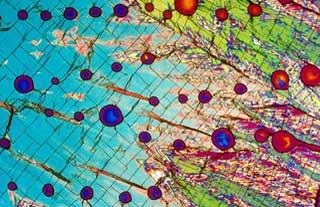

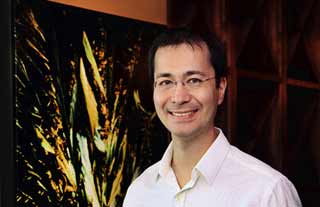
Vodka
White Russian
Lester Hutt
Some drinks such as vodka don't have as many impurities in them as cocktails such as a piña colada so when they break down into their constituent parts
they can fall apart and not dry out properly. This means that photographing something like vodka can take up to 200 attempts to get it right.
"What you can see in the magnified pictures are the crystalised carbohydrates that have become sugars and glucose," explains Lester Hutt, 35, the founder of Bevshots.
It can take up to 4 weeks for the alcohol to dry out completely in an airtight container, and the whole process can take up to 3 months.
Shapes and colours are highlighted by shining natural light on top and through the bottom of the slide.


A tattoo artist shows off the intricate
designs on his head at the Tattoo Convention in Reading, Berkshire. Later, he works on a fresh tattoo on a client's leg.
 Being grumpy makes us think more clearly. In contrast to those annoying happy
types, miserable people are better at decision-making and less gullible. While cheerfulness fosters creativity, gloominess breeds
attentiveness and careful thinking. A grumpy person can cope with more demanding situations than a happy one because of the way the brain "promotes information processing strategies". The study
also found that sad people were better at stating their case through written arguments. Weather has a similar impact on us — wet, dreary days sharpen memory, while bright sunny spells make people
forgetful. Being grumpy makes us think more clearly. In contrast to those annoying happy
types, miserable people are better at decision-making and less gullible. While cheerfulness fosters creativity, gloominess breeds
attentiveness and careful thinking. A grumpy person can cope with more demanding situations than a happy one because of the way the brain "promotes information processing strategies". The study
also found that sad people were better at stating their case through written arguments. Weather has a similar impact on us — wet, dreary days sharpen memory, while bright sunny spells make people
forgetful.
I personally think that anybody who wanders through life in a continuous state of bonhomie either has no idea what's going on around him or simply doesn't care!
 "Ironic, isn’t it?" said Michael Braungart, German chemist, author, and co-founder of a US
design consultancy. "The colour green can never be 'green', because of the way it is made. It’s impossible to dye plastic green or to print green ink on paper without contaminating
them." This means that green-coloured plastic and paper cannot be recycled or composted safely, because it could contaminate everything else. The crux of the problem is that
green is such a difficult colour to manufacture that toxic substances are often used to stabilise it. Take Pigment
Green 7, the commonest shade of green used in plastics and paper. It is an organic pigment but contains chlorine, some forms of which can cause cancer and birth defects. Another popular shade,
Pigment Green 36, includes potentially hazardous bromide atoms as well as chlorine; while inorganic Pigment Green 50 is a noxious cocktail of cobalt, titanium, nickel and zinc oxide. Some early green
paints were so corrosive that they burnt into canvas, paper and wood. Many popular 18th and 19th century green wallpapers and paints were made with arsenic, sometimes with fatal consequences. One
of those paints, Scheele’s Green, invented in Sweden in the 1770s, is thought by some historians to have killed Napoléon Bonaparte in 1821, when lethal arsenic fumes were released from the rotting green and
gold wallpaper in his damp cell on the island of Saint Helena. Getting the right tones of artificial green is always difficult, and there’s often something disturbing about the result, whereas all shades
of green look beautiful in nature. "Ironic, isn’t it?" said Michael Braungart, German chemist, author, and co-founder of a US
design consultancy. "The colour green can never be 'green', because of the way it is made. It’s impossible to dye plastic green or to print green ink on paper without contaminating
them." This means that green-coloured plastic and paper cannot be recycled or composted safely, because it could contaminate everything else. The crux of the problem is that
green is such a difficult colour to manufacture that toxic substances are often used to stabilise it. Take Pigment
Green 7, the commonest shade of green used in plastics and paper. It is an organic pigment but contains chlorine, some forms of which can cause cancer and birth defects. Another popular shade,
Pigment Green 36, includes potentially hazardous bromide atoms as well as chlorine; while inorganic Pigment Green 50 is a noxious cocktail of cobalt, titanium, nickel and zinc oxide. Some early green
paints were so corrosive that they burnt into canvas, paper and wood. Many popular 18th and 19th century green wallpapers and paints were made with arsenic, sometimes with fatal consequences. One
of those paints, Scheele’s Green, invented in Sweden in the 1770s, is thought by some historians to have killed Napoléon Bonaparte in 1821, when lethal arsenic fumes were released from the rotting green and
gold wallpaper in his damp cell on the island of Saint Helena. Getting the right tones of artificial green is always difficult, and there’s often something disturbing about the result, whereas all shades
of green look beautiful in nature.
 Jennifer is
a platonic friend for hire. (Isn't that sort of like a psychologist?) The
reservation-taker at a popular Las Vegas restaurant has accepted cash to show an introverted, out-of-town computer programmer around the Pinball Hall of Fame and the Bellagio's famous dancing
fountains. A bored grandmother visiting family from the Midwest hired her for an afternoon movie. A stay-at-home mom who was new to the area paid her to come on over to do some
scrapbooking. Jennifer met a travelling businessman at the airport with a folder of research he requested on things to do, and helped him rent a car. It's all because of a new arrival to
the web-fuelled, rent-an-everything revolution — Rentafriend.com — at only US$20 — $50 per hour. Two students rented parents to meet with college officials after they were caught drinking on
campus. A woman once hired a college girl to visit her mother in a nursing home 3 days a week after she moved away. In a world where "friend" is a verb and you may never meet some of yours from
Facebook in real life, where research indicates chronic loneliness can lead to depression, suicide, high blood pressure and viral infections, where roughly 20% of all people — 60 million in the US alone — say
they feel lonely at any given moment, is renting a friend a solution? Ori Brafman, co-author with brother Rom of the new book Click: The Magic of Instant Connections, said the concept "seems
really tragic, kind of surreally tragic" in ways that sex services don't because it represents the worst kind of social isolation. "We purchase fleeting replacements because, as a society, we lack those
close, meaningful bonds that are so essential." Jennifer is
a platonic friend for hire. (Isn't that sort of like a psychologist?) The
reservation-taker at a popular Las Vegas restaurant has accepted cash to show an introverted, out-of-town computer programmer around the Pinball Hall of Fame and the Bellagio's famous dancing
fountains. A bored grandmother visiting family from the Midwest hired her for an afternoon movie. A stay-at-home mom who was new to the area paid her to come on over to do some
scrapbooking. Jennifer met a travelling businessman at the airport with a folder of research he requested on things to do, and helped him rent a car. It's all because of a new arrival to
the web-fuelled, rent-an-everything revolution — Rentafriend.com — at only US$20 — $50 per hour. Two students rented parents to meet with college officials after they were caught drinking on
campus. A woman once hired a college girl to visit her mother in a nursing home 3 days a week after she moved away. In a world where "friend" is a verb and you may never meet some of yours from
Facebook in real life, where research indicates chronic loneliness can lead to depression, suicide, high blood pressure and viral infections, where roughly 20% of all people — 60 million in the US alone — say
they feel lonely at any given moment, is renting a friend a solution? Ori Brafman, co-author with brother Rom of the new book Click: The Magic of Instant Connections, said the concept "seems
really tragic, kind of surreally tragic" in ways that sex services don't because it represents the worst kind of social isolation. "We purchase fleeting replacements because, as a society, we lack those
close, meaningful bonds that are so essential." Call a friend today. Keep connected!

Be Careful with Superglue
(German chancellor Angela Merkel apparently wasn't.)
  
You never want a serious crisis to go to waste — and what I mean by that is it's an opportunity to do things that you think you couldn't do before.
— Rahm Emanuel, Obama Chief of Staff

For other updates click "Home" (for the latest) or "Next" (for older) below
|
 Animals
Animals Animation
Animation Art of Playing Cards
Art of Playing Cards Drugs
Drugs Education
Education Environment
Environment Flying
Flying History
History Humour
Humour Immigration
Immigration Info/Tech
Info/Tech Intellectual/Entertaining
Intellectual/Entertaining Lifestyles
Lifestyles Men
Men Money/Politics/Law
Money/Politics/Law New Jersey
New Jersey Odds and Oddities
Odds and Oddities Older & Under
Older & Under Photography
Photography Prisons
Prisons Relationships
Relationships Science
Science Social/Cultural
Social/Cultural Terrorism
Terrorism Wellington
Wellington Working
Working Zero Return Investment
Zero Return Investment






































